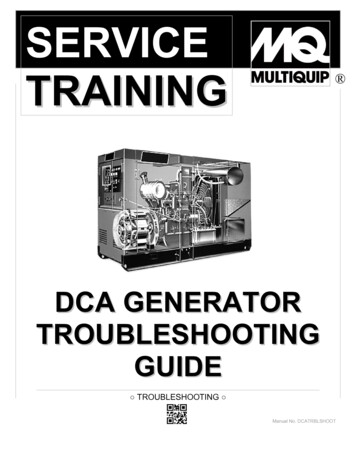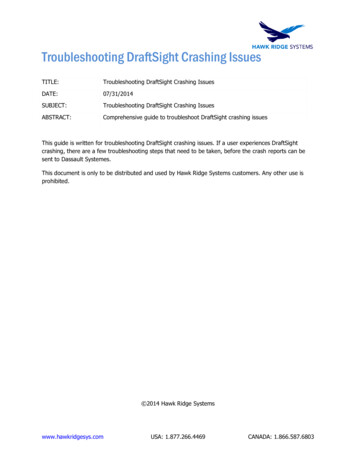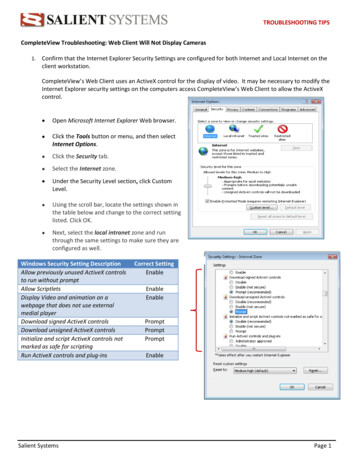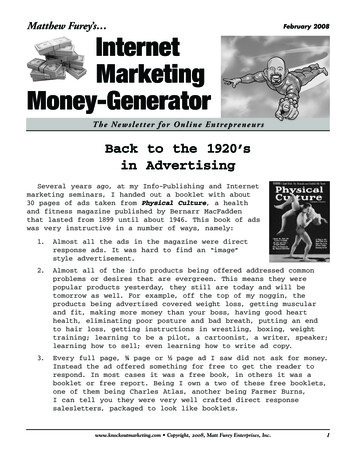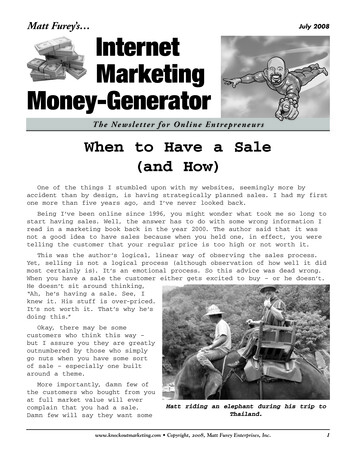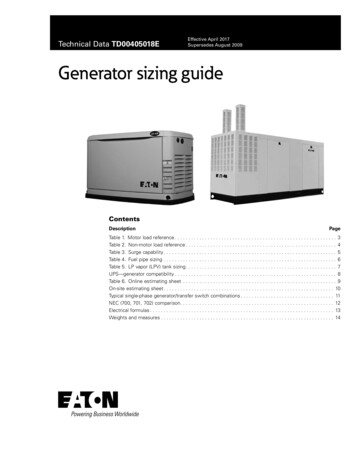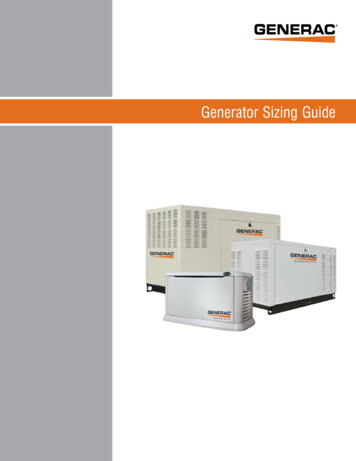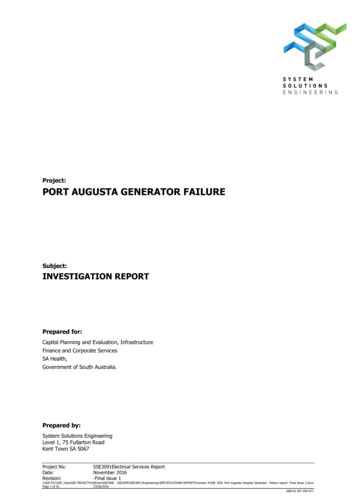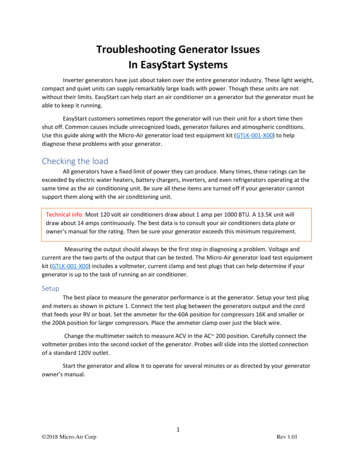
Transcription
Troubleshooting Generator IssuesIn EasyStart SystemsInverter generators have just about taken over the entire generator industry. These light weight,compact and quiet units can supply remarkably large loads with power. Though these units are notwithout their limits. EasyStart can help start an air conditioner on a generator but the generator must beable to keep it running.EasyStart customers sometimes report the generator will run their unit for a short time thenshut off. Common causes include unrecognized loads, generator failures and atmospheric conditions.Use this guide along with the Micro-Air generator load test equipment kit (GTLK-001-X00) to helpdiagnose these problems with your generator.Checking the loadAll generators have a fixed limit of power they can produce. Many times, these ratings can beexceeded by electric water heaters, battery chargers, inverters, and even refrigerators operating at thesame time as the air conditioning unit. Be sure all these items are turned off if your generator cannotsupport them along with the air conditioning unit.Technical info: Most 120 volt air conditioners draw about 1 amp per 1000 BTU. A 13.5K unit willdraw about 14 amps continuously. The best data is to consult your air conditioners data plate orowner’s manual for the rating. Then be sure your generator exceeds this minimum requirement.Measuring the output should always be the first step in diagnosing a problem. Voltage andcurrent are the two parts of the output that can be tested. The Micro-Air generator load test equipmentkit (GTLK-001-X00) includes a voltmeter, current clamp and test plugs that can help determine if yourgenerator is up to the task of running an air conditioner.SetupThe best place to measure the generator performance is at the generator. Setup your test plugand meters as shown in picture 1. Connect the test plug between the generators output and the cordthat feeds your RV or boat. Set the ammeter for the 60A position for compressors 16K and smaller orthe 200A position for larger compressors. Place the ammeter clamp over just the black wire.Change the multimeter switch to measure ACV in the AC 200 position. Carefully connect thevoltmeter probes into the second socket of the generator. Probes will slide into the slotted connectionof a standard 120V outlet.Start the generator and allow it to operate for several minutes or as directed by your generatorowner’s manual.1 2018 Micro-Air CorpRev 1.01
Picture 1GeneratorTest PlugsRV or Shorepower cordCurrent ClampVolt MeterTesting your RV or boatPlug in your power cord and measure the current the generator is producing WITHOUT the airconditioner running. If all the loads are off, you should read 1 amp or less on the clamp on meter. If youare seeing more than a 1 amp reading on the clamp on meter, locate and turn off any additional loads.Start the air conditioner and check the current load while running. The current should rise toapproximately the air conditioner manufacturer’s rated value after 5 to 10 minutes of operation. If thegenerator overloads, or the air conditioner compressor shuts off unexpectedly, continue to the nextsection on “Testing the generator”.2 2018 Micro-Air CorpRev 1.01
Testing the generatorApply resistive loads to the generator like an electric heater, hair drier, heat lamp or other smallappliance. A total load equal to the load expected on your generator is required.Technical info: 15-16A is a good value to use for most RV and marine 120V 13.5K to 16K compressors.What you are trying to do is create a resistive load equivalent to the motor load on the generator. Usean appropriate load for compressors rated current draw for this test. Since these are resistive loadsand not a more variable motor load, there should be no reason for a generator to degrade its outputunless the engine is struggling to keep up.Monitor the AC VOLTS while letting it run for a while and verify the generator can sustain andmaintain this load without fault or overloading. If the voltage drops below 108V (a 10% deviation), that'san indication of there being an engine related problem with your generator. You will likely be surprisedto observe that when you load the generator with the electric heater and the hair dryer, or other smallappliance that the output voltage has dropped very low.Technical info: Compressors are AC induction motors and are therefore an inductive load and they willstall when the applied AC voltage drops below a certain threshold (typically 95 VAC). Furthermore,even before reaching 95VAC, as the applied voltage drops, a heavily loaded AC induction motor willdraw MORE CURRENT, which is OPPOSITE from what other loads will do. This exacerbates theproblem for the generator, thus resulting in a quick "diversion" or "snowball" effect that results in arapid collapse of the output voltage and subsequent stalling of the compressor motor.3 2018 Micro-Air CorpRev 1.01
Problems with air and fuelAir and fuel issues are the most common type of motor problem. Proper maintenance andenvironmental understanding is helpful to resolving generator issues.FuelsThere are many references on the internet on how long gasoline is good when stored. The mostaggressive recommendations are to not use fuel over three months old and then only if it has beenstored in a sealed container. Because there are so many things that can go wrong storing gas, it is bestto stick to strict guidelines and be sure the fuel is as fresh as possible. Use of some fuel stabilizers hasproven to not work reliably through winter storage. You must follow the precise directions to make surethe stabilizer has been allowed to pass through the entire fuel system and carburetor for enough time toensure there are no minute ports that could suffer gum and varnish buildup during a storage period.Generators have fuel filters and air filters that should be serviced regularly. If your generator ismore than a year old or has sat for several months, consider servicing the generator and replacing anyrecommended components.Propane has less unit energy than gasoline so most propane generators produce less than theirgas counterparts. Propane converted generators have a higher loss than those designed specifically torun propane. Be sure to check with the generator manufacturer to see if they offer a rating whenrunning on propane. It may be considerably less than the generators gasoline rating and possibly notenough to run an air conditioner under all conditions.Technical info: Propane-converted generator engines have an estimated 10% lower horsepower ascompared to gasoline. Use of propane as a fuel will therefore cause the point where the enginepower output can no longer keep up with the inverter’s power demand to occur at lower altitudes,lower temperatures, or sooner in the engine’s routine maintenance period. This is important since airconditioning systems will use nearly all of a small generators maximum continuous capacity.4 2018 Micro-Air CorpRev 1.01
AirMost generators are carbureted and calibrated at sea level. The higher in elevation a generatoris operated the thinner the air gets. Often this requires the operator re-jet the carburetor for betterperformance. Most generator companies offer re-jet kits that are labeled based on the elevation youexpect to operate in.Technical info: Engines lose 3% of their power per 1000 feet of elevation due to decreased oxygencontent. In addition since the carburetor is a metering device that does not compensate for elevation,the higher you go the richer the mixture gets. A rich mixture produces less power than an idealmixture, so even more power is lost than the 3%/1000’ estimate. Carburetor re-jet kits change the airfuel ratio back closer to the ideal ratio which regains some of the excess lost power, bringing it back to3%/1000’. Jets must also be changed back when operating at lower elevations or there is an increasedrisk of engine damage due to high temperatures created by lean running conditions.The density of oxygen in the air changes with elevation, temperature and barometric pressure.The technical term for this effect is called density altitude. Pilots and racers know this is what makesengine performance poor on some days and great on others. A generator on a very hot day at 3000 feetmay seem like it is operating at almost 8000 feet. If you are going to operate your air conditioner nearthe limit of the generator output at increased temperature or elevation, you may want to consider thenext larger size generator to ensure reliable operation.Other problems with generatorsIf your generator is putting out less than it is rated for and it is fully maintained, you may needto take it to a service location. Although we do not service generators, we have had reports fromcustomers who have found a myriad of problems including (in order of likelihood): Gummed up carburetorStale fuelClogged fuel filterFouled spark plugWorn spark pugBad ignition coilLow compressionBad valvesBad statorBroken piston ringWarped cylinder due to overheating5 2018 Micro-Air CorpRev 1.01
2018 Micro Air Corporation, All Rights ReservedNo part of this publication may be reproduced, translated, stored in a retrieval system, or transmitted inany form or by any means electronic, mechanical, photocopying, recording or otherwise without priorwritten consent by Micro Air Corporation.Every precaution has been taken in the preparation of this manual to insure its accuracy. However,Micro Air Corporation assumes no responsibility for errors and omissions. Neither is any liabilityassumed nor implied for damages resulting from the use or misuse of this product and informationcontained herein.6 2018 Micro-Air CorpRev 1.01
Troubleshooting Generator Issues In EasyStart Systems Inverter generators have just about taken over the entire generator industry. These light weight, compact and quiet units can supply remarkably large loads with power. Though these units are not without their limits. EasyStart can help start an air conditioner on a generator but the generator must be able to keep it running. EasyStart .
